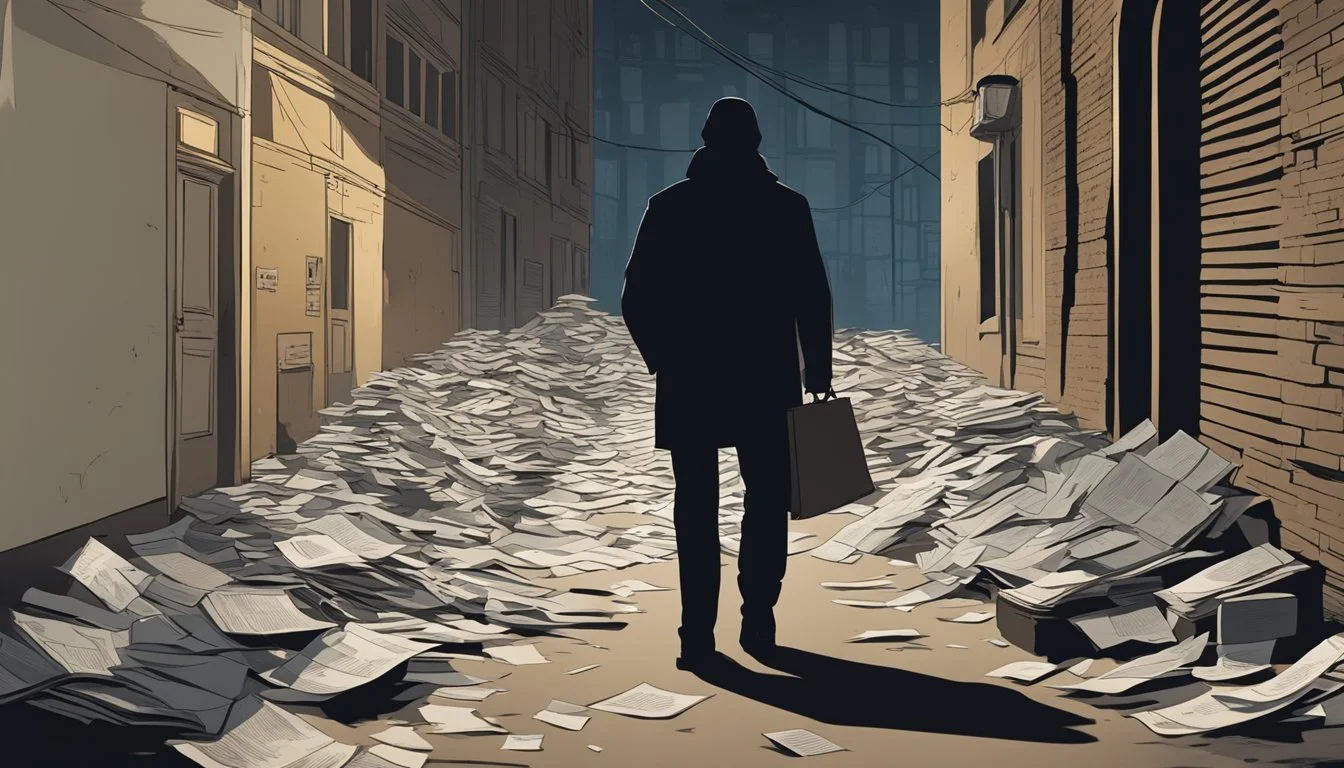Unveiled: The Shocking Truths Behind America's Most Notorious Crimes
Documentary crime has captivated audiences for decades, offering a window into real-life mysteries and criminal investigations. These compelling narratives blend journalistic rigor with cinematic storytelling, bringing true stories to life on screen. True crime documentaries provide viewers with an in-depth look at actual cases, often shedding new light on unsolved crimes or miscarriages of justice.
From classic films like "The Thin Blue Line" to recent series such as "Making a Murderer," the genre has evolved to include a wide range of formats and styles. Streaming platforms have fueled a surge in true crime content, making it easier than ever for viewers to access high-quality documentaries. These productions often feature interviews with key players, archival footage, and expert analysis, allowing audiences to immerse themselves in complex legal proceedings and criminal investigations.
True crime documentaries serve multiple purposes beyond entertainment. They can raise awareness about social issues, expose flaws in the justice system, and even lead to real-world changes in criminal cases. As the genre continues to grow, filmmakers are exploring innovative ways to present these stories, ensuring that documentary crime remains a fascinating and relevant form of storytelling.
Evolution of Crime Documentaries
Crime documentaries have transformed dramatically in recent years. New storytelling techniques, wider distribution platforms, and shifting audience preferences have reshaped the genre.
Golden Age of True Crime
True crime documentaries entered a golden age in the 2010s. Films like "The Jinx" and "Making a Murderer" captivated audiences with their in-depth investigations and compelling narratives. These productions raised the bar for production quality and storytelling in the genre.
Filmmakers began employing more sophisticated techniques, including dramatic reenactments and stylized cinematography. This elevated true crime documentaries from simple retellings to cinematic experiences.
The focus shifted from merely recounting events to exploring the psychological and social factors behind crimes. This deeper approach resonated with viewers, sparking conversations about justice and society.
Impact of Streaming Services
Streaming platforms revolutionized the distribution and consumption of crime documentaries. Netflix, in particular, became a powerhouse for true crime content. The platform's algorithm-driven recommendations exposed viewers to a wide array of crime documentaries.
HBO, Hulu, and newer entrants like Peacock also invested heavily in the genre. This competition led to a surge in high-quality productions and exclusive content.
Streaming services' binge-watching model proved particularly suited to crime documentaries. Complex cases could be explored over multiple episodes, allowing for more thorough investigations.
Rise of Docuseries
The docuseries format gained prominence, offering extended runtimes to delve into intricate cases. This allowed filmmakers to present multiple perspectives and explore various angles of a story.
Series like "The Staircase" and "Wild Wild Country" demonstrated the potential of long-form storytelling in crime documentaries. They balanced entertainment with journalistic integrity, often uncovering new evidence or perspectives.
The success of these docuseries inspired networks and streaming platforms to invest in similar projects. This trend led to a proliferation of multi-part crime documentaries across various platforms.
True Crime and Society
True crime media has a profound influence on society, shaping public perceptions of the justice system and criminal behavior. It engages audiences in complex legal and ethical issues while potentially impacting real-world cases and social dynamics.
Justice System Examination
True crime documentaries and podcasts often scrutinize the justice system, highlighting flaws and inconsistencies. These productions can expose wrongful convictions, leading to case reexaminations and legal reforms.
High-profile true crime series have prompted renewed interest in cold cases, sometimes resulting in new evidence or witness testimony. This increased attention can pressure law enforcement to reopen investigations.
The genre's popularity has also raised concerns about jury bias and trial fairness. Extensive media coverage of criminal cases may influence public opinion and potential jurors before trials begin.
Audience Engagement
True crime content captivates audiences by tapping into fundamental human curiosities about morality and psychology. Viewers and listeners often become actively involved in analyzing evidence and forming theories about cases.
This engagement can lead to heightened awareness of criminal justice issues. Many true crime enthusiasts develop a deeper understanding of legal procedures and forensic techniques.
Social media platforms have become hubs for true crime discussions, creating communities where people share insights and debate case details. This collective analysis sometimes contributes to solving real crimes.
Social Impact
The true crime genre's influence extends beyond entertainment, affecting societal attitudes and behaviors. It can increase public vigilance and promote personal safety measures among viewers.
True crime media often humanizes victims and their families, fostering empathy and support for those affected by violent crimes. This heightened awareness can lead to increased advocacy for victims' rights.
Critics argue that the genre may sensationalize violence and perpetuate harmful stereotypes. There are concerns about the potential glorification of criminals and the psychological impact on audiences exposed to graphic content.
The popularity of true crime has also sparked ethical debates about the exploitation of tragedy for entertainment and the responsibility of content creators to handle sensitive subjects respectfully.
Notable True Crime Docuseries
True crime docuseries have captivated audiences with their in-depth explorations of real-life cases. These shows revolutionized the genre through innovative storytelling techniques and audience engagement.
Making a Murderer and Its Influence
Making a Murderer propelled true crime docuseries into the mainstream when it debuted in 2015. The 10-part Netflix series examined the convictions of Steven Avery and Brendan Dassey for the murder of Teresa Halbach.
Its meticulous presentation of evidence and exploration of potential police misconduct sparked widespread debate. Viewers became amateur sleuths, poring over case details online.
The show's success inspired a wave of similar docuseries. It demonstrated the power of long-form storytelling in true crime, allowing for nuanced examination of complex cases.
The Staircase and the Power of Serialized Storytelling
The Staircase set the standard for serialized true crime storytelling. Filmmaker Jean-Xavier de Lestrade followed the trial of Michael Peterson, accused of murdering his wife Kathleen.
Originally released in 2004, the series was updated with new episodes in 2013 and 2018. This unique approach allowed viewers to follow the case's twists and turns over 15 years.
The Staircase highlighted how time can reveal new evidence and change perspectives. Its intimate access to Peterson and his family provided a humanizing look at those involved in high-profile cases.
I'll Be Gone in the Dark and Crowdsourced Investigations
I'll Be Gone in the Dark broke new ground by focusing on the investigator rather than just the crime. The series chronicled Michelle McNamara's obsessive search for the Golden State Killer.
McNamara's use of online forums and DNA databases showcased the power of crowdsourced investigations. Her work helped renew interest in the cold case, contributing to the eventual arrest of Joseph James DeAngelo in 2018.
The show highlighted how passionate citizen detectives can impact real investigations. It also explored the personal toll of pursuing justice, as McNamara tragically passed away before the killer's capture.
Prominent Cases and Themes
True crime documentaries explore a range of compelling cases and themes that captivate audiences. These films shed light on miscarriages of justice, delve into the psyches of notorious killers, and examine high-profile crimes that shocked the world.
Wrongful Convictions and Their Repercussions
Wrongful convictions have been a recurring focus in crime documentaries. The Central Park Five case gained widespread attention through various films and series. Five teenagers were falsely accused and convicted of a brutal attack in 1989.
Years later, DNA evidence exonerated them. The case highlighted racial biases in the justice system and the devastating impact of false convictions on individuals' lives.
Other documentaries have explored similar cases, revealing flaws in investigative procedures and the long-lasting effects on those wrongly imprisoned.
Serial Killers and Public Fascination
Serial killers have long held a morbid fascination for the public. Documentaries about Ted Bundy and the Night Stalker (Richard Ramirez) have drawn significant viewership.
These films often explore the killers' backgrounds, methods, and the investigations that led to their capture. The Golden State Killer case, solved through genetic genealogy in 2018, sparked renewed interest in cold cases.
Some documentaries delve into the psychological profiles of these criminals, attempting to understand their motivations and the societal factors that may have contributed to their actions.
High-Profile Criminal Cases
High-profile cases often become the subject of gripping documentaries. The Jeffrey Epstein case, explored in "Jeffrey Epstein: Filthy Rich," revealed a web of power, money, and sexual abuse.
"Tiger King" introduced viewers to Joe Exotic and the bizarre world of big cat ownership. The series touched on themes of animal rights, personal vendettas, and eccentric personalities.
These documentaries often go beyond the headlines, offering in-depth looks at complex cases and the individuals involved. They frequently raise questions about wealth, influence, and justice in society.
Ethics in Crime Documentaries
Crime documentaries face complex ethical challenges in portraying real events and people. Filmmakers must carefully navigate issues of consent, accuracy, and potential harm to those involved.
Victim's Rights and Sensitivities
Crime documentaries often depict traumatic events, raising concerns about re-traumatizing victims and their families. Filmmakers should obtain informed consent and allow victims control over their participation. Some choose to anonymize victims or use actors to protect identities.
Ethical documentarians consult with victims about how they wish to be portrayed. They avoid sensationalizing violence or including gratuitous details. Careful consideration is given to the timing of release, as documentaries aired during ongoing investigations or trials may impact legal proceedings.
Potential for Exploitation
The true crime genre risks exploiting tragedy for entertainment. Ethical concerns arise when filmmakers prioritize shock value over sensitivity. Some documentaries have been criticized for romanticizing criminals or giving them a platform.
Financial compensation for participants is a gray area. While payment may be appropriate in some cases, it can also incentivize sensationalism. Ethical filmmakers are transparent about any financial arrangements.
Balancing Storytelling and Journalism
Crime documentaries blend journalistic and artistic elements. Filmmakers must balance compelling narratives with factual accuracy. Ethical standards include thorough fact-checking, presenting multiple perspectives, and clearly distinguishing speculation from verified information.
Visual techniques like reenactments should be clearly labeled. Editing choices can shape audience perceptions, so responsible filmmakers avoid misleading manipulations. They also consider the broader societal impact, such as perpetuating harmful stereotypes about crime.
Digital Engagement and Technology
True crime documentaries increasingly leverage digital tools and platforms to engage audiences and enhance storytelling. This shift has transformed how creators present cases and how viewers interact with content.
Use of Data in True Crime Storytelling
Data analysis plays a crucial role in modern true crime documentaries. Filmmakers utilize digital evidence like cell phone records, GPS data, and social media activity to reconstruct timelines and illustrate criminal behaviors. Smart devices and fitness trackers provide crucial information about victims' movements and suspects' whereabouts.
Digital forensics tools help analyze internet searches, app usage, and electronic communications. These data points often become key elements in the narrative, offering viewers insights into the investigative process. Documentaries like "Witness to Murder: Digital Evidence" showcase how technology has become essential in solving homicides.
Role of Social Media in Crime Documentaries
Social media platforms serve as both sources of evidence and channels for audience engagement in true crime documentaries. Creators use social media to gather information, connect with witnesses, and crowdsource leads. Platforms like Facebook and Twitter allow viewers to discuss theories and share reactions in real-time.
Some documentaries incorporate social media content directly into their narratives, displaying tweets, posts, and comments to illustrate public reactions or suspect behavior. This integration of social media enhances the immediacy and relevance of the storytelling.
Documentaries may also leverage social media for promotion and audience building, creating dedicated accounts to share additional content and foster community discussions.
The Effect of Personalization on Content
Streaming platforms use data analytics and machine learning algorithms to personalize true crime content recommendations. Viewers' watching habits, search history, and ratings inform the selection of suggested documentaries and series.
This personalization can lead to more engaging viewing experiences, as audiences are presented with content aligned with their interests. However, it may also create echo chambers, limiting exposure to diverse perspectives on crime and justice.
Tailored ads and customized homepages on platforms like YouTube further shape the true crime content ecosystem. Privacy settings and cookie preferences influence the level of personalization, allowing viewers some control over their digital engagement with crime documentaries.
Challenges and Controversies
Documentary crime filmmakers face significant ethical and practical hurdles. Legal constraints, misinformation, and sensitive subject matter present complex obstacles.
Dealing with Legal Hurdles
Filmmakers must navigate strict legal boundaries when covering active criminal cases. Access to evidence and key figures is often restricted. Courts may impose gag orders, limiting what can be discussed publicly.
Many documentaries risk defamation lawsuits if they make unproven claims about suspects or defendants. This can force directors to rely heavily on already public information.
Some films have directly impacted ongoing investigations. "The Jinx" famously led to Robert Durst's arrest after he made incriminating statements on camera.
Confronting Myths and Misinformation
True crime documentaries often tackle popular misconceptions about cases. Directors must balance engaging storytelling with factual accuracy.
Sensationalized media coverage can embed false narratives in public consciousness. Films like "Allen v. Farrow" aim to reexamine high-profile cases through a more critical lens.
Social media rumors pose a growing challenge. Filmmakers increasingly need to address conspiracy theories that spread online about crimes.
Discussing Sensitive Issues
Covering traumatic events requires careful consideration of victims and their families. Some documentaries like "Surviving R. Kelly" give voice to survivors of sexual assault.
Films about cults or serial killers risk glorifying perpetrators. Directors must weigh public interest against potential harm.
Documentaries on systemic issues, such as "The Crime of the Century" about the opioid epidemic, grapple with complex societal factors behind criminal behavior.
Ethical debates surround the use of graphic crime scene footage or reenactments. Filmmakers must decide how to depict violence without exploiting victims.
The Future of True Crime Documentaries
True crime documentaries continue to captivate audiences, with new trends and technologies shaping their evolution. The genre is poised for significant changes in storytelling approaches and production techniques.
Trends and Predictions
Interactive elements are gaining traction in true crime documentaries. Viewers may soon have the ability to explore case evidence and timelines at their own pace. Virtual reality experiences could allow audiences to step into crime scenes and examine details firsthand.
Serialized formats are likely to remain popular, with multi-episode arcs delving deep into complex cases. Producers may focus more on unsolved mysteries, encouraging viewer participation in ongoing investigations.
Ethical considerations will play a larger role. Documentarians are expected to place greater emphasis on victim perspectives and the impact of crimes on communities.
Technological Advancements in Filmmaking
High-definition cameras and drones are enhancing visual storytelling in true crime documentaries. Aerial footage and immersive crime scene reconstructions offer viewers new perspectives on familiar cases.
AI-powered editing tools may streamline post-production, allowing for quicker turnaround times on documentary series. Advanced facial recognition and voice analysis technologies could aid in identifying suspects and verifying witness accounts.
3D modeling and augmented reality might be used to recreate crime scenes with unprecedented accuracy. These tools could help viewers better understand spatial relationships and sequence of events.
The Expanding Horizon of Crime Storytelling
True crime documentaries are branching out beyond traditional murder cases. White-collar crimes, cybercrimes, and environmental offenses are gaining attention as subjects for in-depth exploration.
Cross-platform storytelling is emerging as a trend. Documentaries may be accompanied by podcasts, interactive websites, and social media campaigns to engage audiences across multiple channels.
International collaborations are likely to increase, bringing lesser-known cases from around the world to global audiences. This expansion may lead to a more diverse range of perspectives and storytelling styles in the genre.





